-
Posts
2,461 -
Joined
-
Last visited
-
Days Won
38
Content Type
Forums
Detector Prospector Home
Detector Database
Downloads
Posts posted by jasong
-
-
Is the X Coil more sensitive than the smallest stock coil in mild to medium ground at sacrifice of reducing ground balancing in hot ground? Or is it about the same sensitivity as the stock coils in mild ground but also failing to ground balance in hot ground?
I'm just kinda curious as a general point of interest if either of the 2nd gen PI's have any performance to be gained by coils at all, or if they are both already maxed out internally and coils are more just for geometry/size preference on both the 6000 and Axiom. I guess that is already clear for the 6000, wasn't sure if it was demonstrated for the Axiom or not yet?
-
Too cool, nice find.
I've never seen something like that before and you are kinda in my neighborhood there on the Yellowstone too. If you find a name for it, post it back here? That would definitely be something to go hunting for the source!
Almost wonder if it was agatized as part of a sea shell or something?
-
$1000 increase on the 15 year old 5000? Hilarious. That machine could sell for $1000 total and still make them a profit, not to mention it's patents are going to expire soon, if some haven't already. $1000 increase on the SDC isn't much better.
Brutally greedy moves there. I'd guess the US price list won't be so shocking, but will be interesting to see.
-
Almost looks like a septarian nodule, but not quite. Maybe something similar though.
It looks like calcite and siderite inside. Try scratching some of the whitish crystal to powder with a knife or nail, and put vinegar on the powder and see if it reacts (some crystalline structures can act to resist rapid acid reactions). Might try a stronger acid if you have one too, like hydrochloric, or maybe even CLR (or heat up the vinegar - acid is stronger the hotter it is).
I suspect researching Pennsylvania specific geology would expose some suspects though, or maybe someone more familiar with East Coast geology would know specifics. Anything East of the Rockies is foreign to me.
-
What do you mean by "makes your hand feel funny"? Can you take a photo in focus on the mineral?
Does it float in water?
I'd guess based off no real data here something like pumice or maybe vermiculite (mineral, not expanded). Or maybe just some man-made cinder, clinker, or other slag type stuff.
-
2 hours ago, GotAU? said:
It looked like a great way to teach how to read topographic lines and about different types of landforms for students.
For sure, I'm thinking about making something for the science center here too since they don't have a geology section. These would be more useful I think though if they were much larger, which is why I was thinking a CNC router might be better. I could make something like almost 2ftx4ft, which would be like a table top size. The 3D printed route though you can place colors at specific elevations, highlighting layers/topographic features, which you can't do with CNC, also the "topo lines" of relief are automatically added by slicer since it prints in layers. The ISU site does have a tiling feature which I haven't tried yet, so you can print and then glue multiple models together to make a larger model.
I'll just answer your PM questions here in case others are curious - the size of the one I showed is roughly 4"x6", but I've made a few 6"x9" ones too (whatever the 160mm and 200mm ISU sizes work out to be). My printer bed maxes out at 10" but you need room for the extrusion tower if using multiple colors. They take anywhere from 2 to 10 hours to print depending on the topography/size. Way less time if single color, but I only did multi-color so far.
Printer is a Bambu X1C w/AMS. It's overkill, a P1 would work equally well. The Bambu slicer does a crazy good job calculating infill - it's 10% infill using adaptive cubic. No supports. PLA for filament, PLA Carbon Fiber for the black parts (not shown on this print). 0.4mm nozzle, 0.3mm layer height (0.2 gives you more "topo lines" of relief, but slower). Ironing on top layer w/15% flow - but I'm getting top layer inconsistencies on the widest flat parts. Sometimes the slicer adds a raft or brim, other times it randomly doesn't.
Definitely ways to improve, but I'm still learning, and those settings seem to produce a decent model. More infill would make a more weighty model, these are pretty light, but I set it low to reduce printing time.
-
16 minutes ago, Gerry in Idaho said:
Your capabilities on the computer are as good as your detector skills. The only difference is I feel the one that will make you the most money, may not be detecting. Great input and I love the detail.
Thanks, and yeah I definitely threw in the towel on detecting for dollars, it was brief but fun. 😄
Gold is easy to get motivated by and to keep a guy walking/ATV'ing around all day though, it's not easy to wake up in the morning and be like "heck yeah, I wanna go find some phosphates!" day in and day out in the same way gold will keep calling a guy back daily, but some of those secondary discoveries actually are quite valuable. Nowadays I try to use gold exploration as an excuse to get out and see what other things I can find while I'm out there.
-
Agree with others. Another issue I found with the auto setting on the 6000 is that it appears to "remember" past auto adjustments beyond the point of time those adjustments were needed. And you have no way of knowing what it's currently set to. For instance if you hit some massive iron, leave your coil over it, it will back off the sensitivity. Sometimes it adjusts back quickly, other times it takes longer, and in one case where I was testing that phenomenon in air it simply never readjusted, even after turning off and back on! I was suspecting for a while it was doing this while detecting highly variable ground too - going from magnetite saturated soils to regular soil (stream banks/bottoms, etc), and the machine was desensitizing itself and staying that way.
It also appears to adjust sensitivity based on varying EMI conditions too, but I'm not 100% positive on that.
It's impossible to know what's happening, and it seems to have a mind of it's own, it's hard for me to get some measure of repeatability to say anything specific. There is no graphical readout displaying the current settings in Auto either, so who knows.
And I alllllmost suspect it's doing this same adjusting to a lesser degree in Manual too. In fact, I was confident that was happening to some degree last year, but I forget exactly why I drew that conclusion now. I think this is part of what "Geosense" is.
That said - I use the 6000 for 90% of my detecting now, and I'd say most of that time I still use Auto+. For general exploration it's just not required to try to catch everything, and most the targets are easy targets anyways. So, I just use the quietest, fastest method, and that is Auto+. If you are reworking patches or small areas though, Manual would be the way to go.
-
2 hours ago, cobill said:
@jasong Great project and very complicated for us dinosaurs!😂 I watched The Prospecting Geologist YT video this morning on 3D & LIDAR and got lost after 3 minutes. You could make some good money printing maps for customers(I would buy one on NNV) and I guess we know where your headed next.
Haha nah, detecting not in the cards for me this winter, most my time is taken with non-gold mineral projects now. Rich Hill area just has some visually interesting topography and is somewhat recognizable.
I actually already printed one of NNV but I put a bunch of super duper top secret info on it, so I didn't photo it. 😁 Problem I'm still trying to solve with the flatter areas like NNV is that sometimes the top surface gets little missed surface spots (you can see some in the bottom left of the photo above too). It appears to be a glitch with the printer since it only happens sometimes, but in any event the quality I'm not sure is high enough to sell unless I figured that out. But I think maybe a CNC version might be higher quality instead of 3D printed? That's next Christmas I guess haha.
However, I used carbon fiber filament on one last night and it looks ultra finished like a cast model, and no missed spots, so maybe that's the trick. That filament is pricey though, and destroys nozzles too, especially over large prints that take 4-12 hours.
On mine I put one color at the topmost shoreline of Lake Lahontan, so you can easily see where it was over a large area. Similarly on another map, I have at an elevation I've found via field work to host a paleoplacer which is mostly buried, but the colors show locally eroded places beneath that to ATV to and investigate if the river might be exposed there. Etc, etc. You can see this stuff on Google Earth with a lot of scanning/zooming, but it takes like 5 seconds to see it all at once on these models.
2 hours ago, Clay Diggins said:You are welcome to use my DEM and drape if you can figure out how to print it.
Thanks, I'd love to be able to drape graphics over these. I just can't find a good way yet short of hand painting.
In my mind I think it might be possible to hack a method by adding a final layer option into an open source slicer and have it draw "pixels" composed of 3 dots of varying size - red, green, and blue. Essentially - emulate a TV or monitor. This is beyond my skillset though, and I think would require a nozzle to change to something as small as possible.
I have a simpler hack idea that might work, but it'd be basic paths/shapes only and not nice aerial imagery. But I have a million ideas for a million things and it's rare for me to ever get to actually finishing one so I'll probably never get to it. 😄
-
I bought myself an early Christmas present in order to make a few specialized brackets/clamps that I didn't want to pay to get manufactured. Finishing that, I decided to print myself a desk ornament.

And here it is complete, I just spitballed the coloration at the point the old gravels stop and meet the granites. These models are pretty useful for estimating paleo surface and drainages and whatnot if you spend the time and get more accurate with the coloring and go to 4 colors. I'm still trying to work out a hack to get a topo map or a geologic map printing on the top surface, haven't figure out how yet though.
These are good for scaling up to like 500 square miles and mapping specific elevations with different colors, and quick visualization of that sort of data, for exploration purposes. You can do similar in Google Earth but it's plane feature in 3D view is buggy and shifts heights, which has caused me to unknowingly miss some areas on aerial research. Also, there is just something more intuitive about having the physical model in hand and seeing the topographic relation of all the terrain.
You can make your own .STL's from DEM data for any location in the world here: https://touchterrain.geol.iastate.edu/
-
1 hour ago, Gold Catcher said:
I enjoy the swinging and hiking. Also, this sort of heavy machinery will only work in open terrain and with large coarse gold deposits. Not many places in the Sierras that I can think of where this would be of any use, not even for the "professionals"...
Re-read my post. A person doesn't use the kind of tools I'm talking about for finding nuggets directly. You use large scale, low resolution tools to cover large swaths of land to find indicators, then go in with a 6000 or 7000 and do the higher resolution work. And not everywhere is the Sierras.
I posted the STMR only as an example that Minelab is working on stuff other than coil on a stick paradigms, things which over the last few years now might be adaptable to something more mobile like drone whereas not long ago it was thought impossible. GPR already is being used on drones. Other stuff too. If they have the bulk designed for military applications, my point is they might be able to do some sort of drone based consumer product as well.
There are tons of examples you can use this equipment to find nuggets by proxy, some of which I'm not at liberty to disclose at the moment. But for example you can use drone mounted GPR to search for buried paleoplacer and paleoriver channels (you are finding the gravel/boulders, not the nuggets), then use that map to go in with a detector or even an excavator. Saving years of boots on the ground surveying/test holes/exploration. Similar techniques abound with other sensor arrays (spectral, radiation, magnetic, etc) which a creative and knowledgable prospector can apply in new ways.
You can use these survey techniques to find gold, or almost any other mineral, limited only by your creativity and ability to find new ways to correlated specific types of survey data to indicators or minerals of interest. I'm not guessing, I'm saying this based on real experience, most of which unfortunately at the moment is under NDA but I may detail further in the future if I can.
This is the direction the future of general prospecting is going. Most people here think detectors have reached maturity - I'm saying with first hand experience that there are still ways to find both more gold as well as other minerals with some of this tech that is now available. If Minelab is charging pro prices and marketing as pro equipment, I'd like to see them offer some of these at a consumer level now. Those who just want to "swing and hike" are free to do so in any event with what exists already.
-
If we are gonna pay the piper then I'm hoping Minelab is moving to some sort of automated prospecting type packages, specifically drone mounted. Drone mounted GPR is real and a thing already in the exploration industry for example, so some things are now possible that were extremely difficult or impossible 10 years ago. Most of this stuff isn't useful for say finding 1 gram nuggets, or recreational detecting though. It's larger scale, lower resolution, bigger picture. But automated. Then you can come back with a 6000 or 7000 or whatever and do the finer scale, higher resolution work.
Minelab has some stuff that seems like they are working on ideas like these already, but limited mostly to countermine military tools. Anyone looked at their STMR Array? Wouldn't be hard to make a smaller adaptation of that to satisfy the drag coil crowd.
I keep hoping we are moving from the coil-on-a-stick model. Probably not though. But who knows. But if they are marketing "pro-grade" equipment and charging pro prices, then I feel it's time to give us actual professional exploration tools and not recreational equipment.
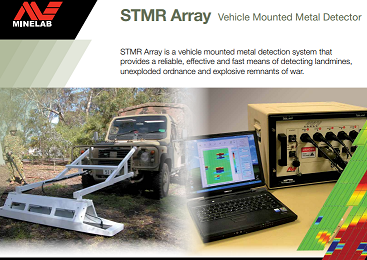
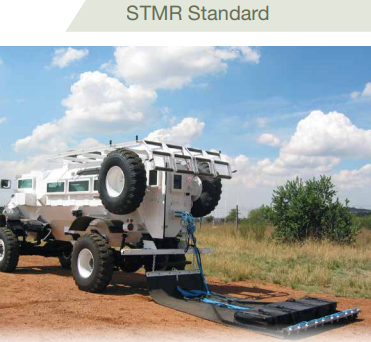
-
1 hour ago, Jim in Idaho said:
Great work, Jason!
Jim
Thanks, it was actually the geologist on another forum that posted about those patterns though, so he solved it by proxy. 🙂 I just ran into it on the net and recognized it.
Not often I learn something completely new, but this was one I really had no idea about. Even knowing the term now, I still can't find reference to it in any hardcopy books I own. That's why I enjoy these rock ID's sometimes, if it's something I don't recognize immediately, I usually learn something new that I wouldn't have learned otherwise.
-
Ok! Mystery solved after half a year - these are called "Westerstetten" patterns and often - as guessed here - occur as chert concretions or nodules. Or, as this book says - are chert nodules with secondary growth.
Still, there is no clear concensus on formation mechanism it seems.
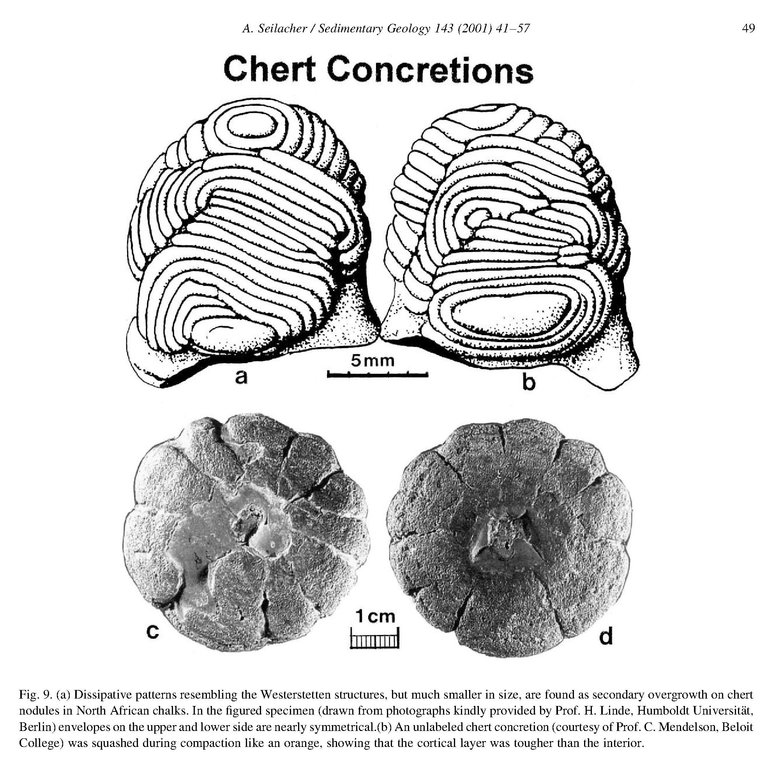 "
"
Here is another from Tennessee. Another geologist mentioned these patterns in reference to this rock, and I think he is spot on, and it's also how to classify the mystery rock OP posted to this forum.
Another example (diagram source): https://www.thefossilforum.com/topic/87174-unidentified-object-from-east-tennessee/
-
Do you mean the noise doesn't increase when swinging?
What I'm trying to get at is this: excessive noise when not swinging indicates either bad EMI or a potentially defective unit. EMI can be dealt with to varying degrees by using Low or High Smoothing, and decreasing the threshold. All of these also reduce the sensitivity to fast transient (tiny/specimen gold) or deep gold too though. If those don't reduce the noise then I'd take it to your dealer and compare it to another GPZ as there may be a defect.
If the noise increases when swinging then its mineralization, or a bad coil/cable. If the coil isn't knock sensitive and the cable isn't making noises when moving (and your coil connector is screwed in tight, double check), then it's likely mineralization.
If it's mineralization, there are two types - salt and iron based. Salt gets (much) worse when wet and this is how you can easily tell if there is a salt component in the soil (you can also often taste a slight salt taste), and the GPZ is notoriously noisy in salt. In these cases you can either power through it and learn to listen for the gold under the salt signal (salt signal is broad/wide/slow, a nugget will be sharper/quicker/narrower). It's a learned trick, just dig sharper signals. Reducing gain sometimes helps in salt, sometimes smoothing helps tame the mess, and for similar reasons lowering the threshold can help make things less chaotic too.
If it's iron based mineralization then Klunker's setting advice is good. Personally I tend to try Difficult/General and go with a conservative sensitivity in heavy iron soils, but it's not my wheelhouse because honestly I just tend to avoid soils that require me to switch to Difficult and move somewhere else instead, so I'm not the best to listen to there.
Note: you can have both salt and iron mineralization in the same soil. These are particularly noisy and difficult to detect.
-
Is it loud when sitting still or only loud when you are swinging?
Does it get quieter when the ground is dryer, over the same patch of ground?
-
5 hours ago, phrunt said:
Out of interest, the people getting shorter than expected battery life from their 6000 batteries, when they first got the detector did they fully charge the battery before turning on the detector for the first time?
I get about 5 hrs per battery now. I charged them both before using.
I dont really fully discharge them often. I just put one on my solar charger every time I move location so that I don't run out the next morning, keep switching. That may decrease the life, dunno?
-
Good rubber sheet is what I'd try too, unless more rigidity is desired. Rubber sheet is what we used for abrasion resistance in the oilfield on gravels. Industrial hose places sell rubber sheet here in various thicknesses in most towns, dunno if they do over there or not.
-
2 hours ago, cobill said:
I've given up on the concept of trying the Mothership drag coil setup, too many problems with coil control (Doc said it's a PITA around bushes/rocks) reduced sensitivity and depth. Now I'm looking for a 22" CC coil for better coverage, sensitivity and depth. I've heard, just last week, there are still big lunkers being found in NNV and it's time for me to find my first 1 oz+.

Keep those reports coming.
Bill
In NNV just keep in mind what I've said. This 22CC is a large coil on the GPZ - both pieces of equipment are recipes for reduced depth in salt environments and difficult operation. PI's are more immune to salt, have more controls regarding salt, and may actually get better depth if the ground is damp.
On the other hand, if you are hunting crystalline gold, then the GPZ will almost always get better depth on that stuff in any soil, so it depends where you are using it here.
I'd go for the 22CC because you have the dream. But I would be prepared to have a ton of patience in NNV with it. I could use this thing all season in Arizona and have a lot of success. But honestly, there are only a small handful of places I am going to use it in NNV and most my detecting will be with the 6000 because it's so much more immune to salt and so, so much quicker to swing and cover more ground with.
-
Got out of the damp salt ground today and into some quiet ground where I could just listen to the coil.
This thing is surprisingly quiet for a large coil, in terms of EMI. The 6000 was screeching like a crazed weasel if I tipped it 20 degrees off flat, so I know EMI was around. Usually any large coil starts to get really unstable in EMI, but this one seems to do good, here at least. I was able to tip it up and detect angled wash banks without much issue. If I just sat it on the ground not moving, it was pretty quiet, much quieter than the 6000. Much quieter than I remember my 18" mono on my 4500 being here too, but that was quite some time ago so maybe my memory is bad.
That said, didn't find anything. Its been said before, but in general NNV is not a great place for deep coils, due to soil deflation. I think there are only a few places where they'd really pay off, and these are spots with known nuggets deeper than 18", and larger than 1 oz. Anything else, 15" CC or the 6000 are the way to go IMO - the 6000 just destroys the salt, I can detect so fast with it that I can cover more ground than I think I could cover with a drag coil honestly.
-
2 hours ago, markinswpa said:
Not seeing it listed on their website. Can I ask where this info came from ? Been a long time coming if accurate. Thanks for sharing. Mark
FCC authorization website. https://apps.fcc.gov/oetcf/eas/reports/ViewExhibitReport.cfm?mode=Exhibits&RequestTimeout=500&calledFromFrame=N&application_id=Gh4QGgRuAVf99u4A1R1CNA%3D%3D&fcc_id=Z4C-0061
It's usually a few weeks or months after showing up at the FCC before a product is listed for sale.
-
Metal detectors aren't spectrometers, discrimination doesn't identify metals in a sample, they just guess at it and are often wrong.
Don't rely on a metal detector to tell you if there is or isn't iron in anything. They will tell you solid gold is iron, and rusty iron is silver. And then it'll tell you something completely different on the same targets buried in different ground. Again, they are not spectrometers, they just detect the presence of metal, type of metal is a "best guess".
-
To my knowledge almost all meteorites that contain metallic iron also contain metallic nickel - the two occur together in alloy form. Alloys are not equal to their component parts, the alloy acts like its own thing in many or most respects.
This probably accounts for the metal detector not ID'ing specifically as iron.
Some meteorites also contain trace amounts of other native metals including gold, PGM's, etc. Though I doubt those are detectable by metal detectors, but may alter the characteristics of the alloy somewhat.
-
That's good if its for the Manticore, et all. Because I really want a speaker on whatever new gold detector they come out with, and no external modules because it's just one more thing to keep track of and have to charge...easier to do in town then on an ATV and backcountry.
I just drove 800 miles to find out I forgot my WM12. Thankfully that wasn't the first time though, and I found a backup WM12 I bought last time I did this, shoved into a pocket in my ATV that I forgot I had too.
I'd love to see a new gold detector, but man, after running that 22" CC, I don't know they can get much deeper than that. Really just want a GPZ+X Coils performance, except way lighter, better in salt, and way improved EMI performance. That'd be pretty much the last machine I'd really need, unless it was some automated drone type prospecting detector or something.
I also really want a set of normal, easy to wear glasses that overlays a track of exactly where I've walked onto the ground, so I can keep track of places I still need to detect when gridding. In salt flats where everything looks the same, too easy to miss big chunks of undetected ground. A little VR/augmented reality maybe. I looked into making a set of these myself, I think it's actually possible. But then I got sidetracked looking at adding a Coral.ai tensor unit to the RaspPi and processing all kinds of visual data, and then of course my project got too complicated and I set it all aside and forgot about it as I had 5 other ideas by then, as always, short attention span.



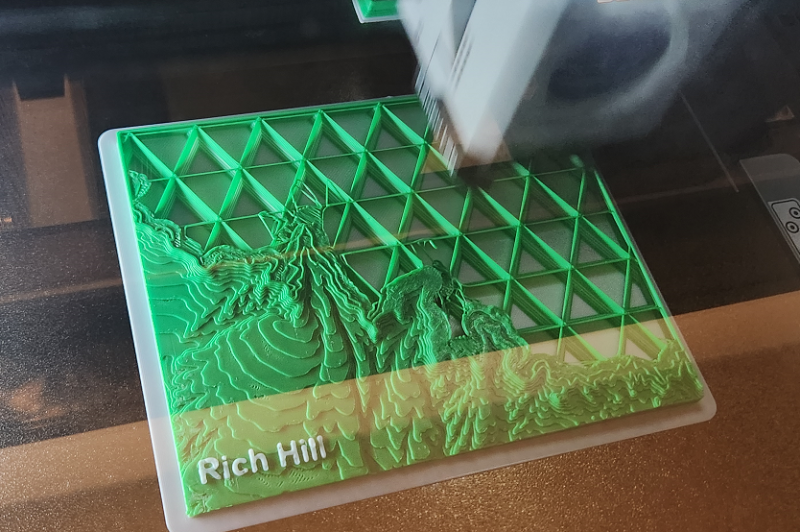
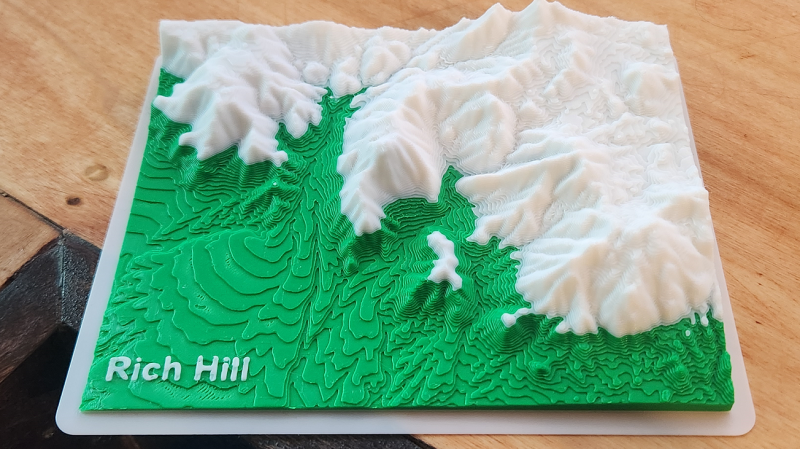
Brass Sieves Price Lowered
in Metal Detecting & Prospecting Classifieds
Posted
Don't happen to have the vibrating stand for that stack you want to sell separately do you? I have a set of 8" sieves but no shaker.